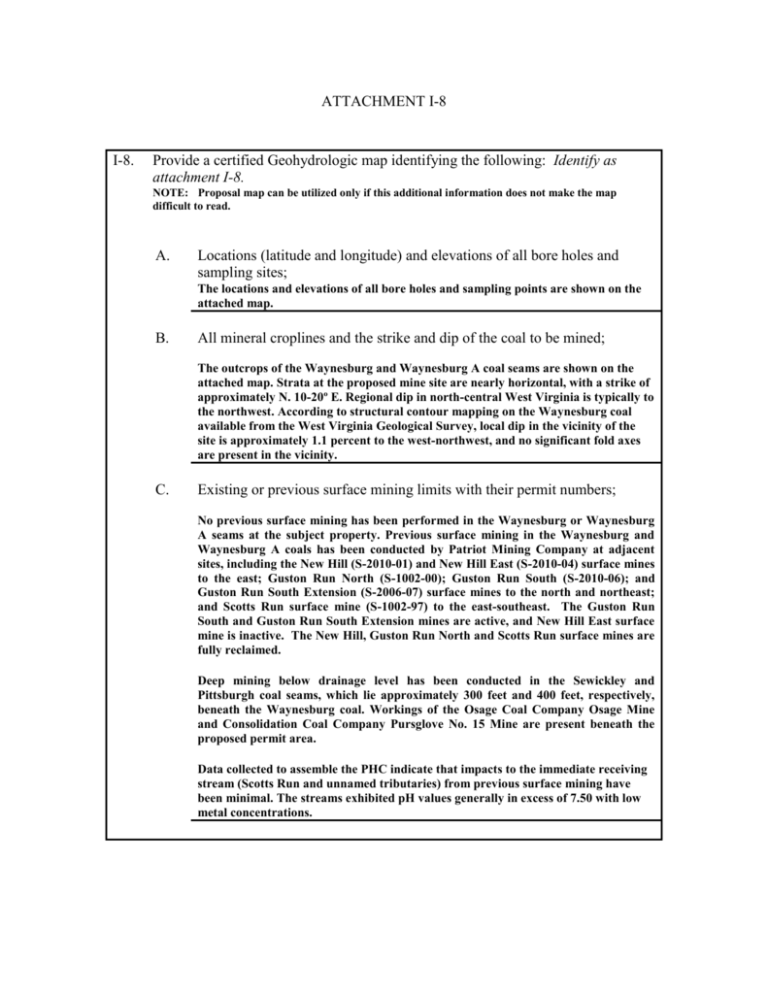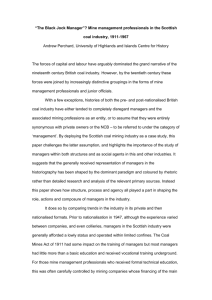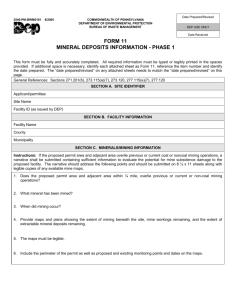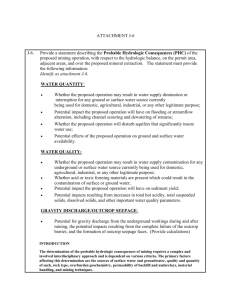Attachment I
advertisement

ATTACHMENT I-8 I-8. Provide a certified Geohydrologic map identifying the following: Identify as attachment I-8. NOTE: Proposal map can be utilized only if this additional information does not make the map difficult to read. A. Locations (latitude and longitude) and elevations of all bore holes and sampling sites; The locations and elevations of all bore holes and sampling points are shown on the attached map. B. All mineral croplines and the strike and dip of the coal to be mined; The outcrops of the Waynesburg and Waynesburg A coal seams are shown on the attached map. Strata at the proposed mine site are nearly horizontal, with a strike of approximately N. 10-20º E. Regional dip in north-central West Virginia is typically to the northwest. According to structural contour mapping on the Waynesburg coal available from the West Virginia Geological Survey, local dip in the vicinity of the site is approximately 1.1 percent to the west-northwest, and no significant fold axes are present in the vicinity. C. Existing or previous surface mining limits with their permit numbers; No previous surface mining has been performed in the Waynesburg or Waynesburg A seams at the subject property. Previous surface mining in the Waynesburg and Waynesburg A coals has been conducted by Patriot Mining Company at adjacent sites, including the New Hill (S-2010-01) and New Hill East (S-2010-04) surface mines to the east; Guston Run North (S-1002-00); Guston Run South (S-2010-06); and Guston Run South Extension (S-2006-07) surface mines to the north and northeast; and Scotts Run surface mine (S-1002-97) to the east-southeast. The Guston Run South and Guston Run South Extension mines are active, and New Hill East surface mine is inactive. The New Hill, Guston Run North and Scotts Run surface mines are fully reclaimed. Deep mining below drainage level has been conducted in the Sewickley and Pittsburgh coal seams, which lie approximately 300 feet and 400 feet, respectively, beneath the Waynesburg coal. Workings of the Osage Coal Company Osage Mine and Consolidation Coal Company Pursglove No. 15 Mine are present beneath the proposed permit area. Data collected to assemble the PHC indicate that impacts to the immediate receiving stream (Scotts Run and unnamed tributaries) from previous surface mining have been minimal. The streams exhibited pH values generally in excess of 7.50 with low metal concentrations. ATTACHMENT I-8 I-8 (continued) D. Location and extent of known workings of any underground mines and auger mined areas, including mine openings to the surface. Label these openings as to whether they are currently discharging water or are known to have discharged water in the past; Four punch mine openings in the Waynesburg coal were observed at the site during a pre-inspection. One opening located southeast of existing Pond No. 2 exhibited no discharge. One opening located about 400 feet southwest of NH-13-08 had a pipe installed as if to promote drainage, although no flow was observed on the date of the pre-inspection. The third opening is about 400 feet southwest of NH-9-08, and exhibited no discharge. The final opening is located about 700 feet northwest of NH9-08, and exhibited no discharge. All openings will be mined out during the proposed mining activity. Deep mining activities have been conducted beneath the site in the Pittsburgh and Sewickley coal seams, which are respectively about 400 feet and 300 feet below the Waynesburg seam in elevation. No discharge is known to have occurred presently or in the past from deep mine workings on the proposed minesite. E. Areal extent of aquifers with the name(s) of the stratum (or strata) in which the water is found and show the anticipated direction of water movement; Three hundred eighty two properties within a one-half mile radius of the proposed operation were inventoried for water use. Ten residences were found to use groundwater from wells or springs as the sole source of water supply. The remaining residences obtained water from municipal lines maintained by Morgantown Utility Board (MUB) or Pleasant Valley PSD. Fourteen residences with city water service maintain a well, spring, or pond as an alternate water source. Most inventoried wells and springs are located in valley bottom areas below the elevation of the Waynesburg coal. These groundwater sources appear to tap the stress-relief fracture aquifer system along local stream valleys as a source of water. The presence of groundwater was not noted on the drillers’ logs for any of the overburden tests. Based on general stratigraphic information for the Monongalia County area, expected potential aquifers in the area to be mined include the Waynesburg coal and the overlying Waynesburg sandstone. These units appear to have been locally developed at W-2 and W-3 which are within the proposed mining area and will be removed by mining. General groundwater movement in abovedrainage strata is down gradient to outcrop discharge areas. Groundwater flow in deeper strata is most likely controlled by stratigraphic dip. A shallow aquifer system is located in nearby valley bottom areas in the vicinity of the proposed mine. The presence of this aquifer system is believed to be largely related to the stress-relief fracture system discussed in Section I-9.C more so than local lithology. All but two of the primary groundwater sources documented during the inventory are completed in this aquifer system. Aquifers at greater depth below drainage level may be at least partially dewatered by deep mining activities in the Sewickley and Pittsburgh coal seams beneath the proposed mining area. According to structural contour maps available at the West Virginia Geological Survey, the Sewickley and Pittsburgh coal seams lie approximately 300 feet and 400 feet, respectively, below the Waynesburg coal. ATTACHMENT I-8 I-8 (continued) F. Location and depth of all oil and gas wells, and their Office of Oil and Gas permit numbers, for all wells which are within the proposed mining limits (surface or underground) and/or within 1000 feet of the proposed permit boundary; No gas wells are located within the bonded area. G. Presence and attitude of any known structural features such as faults; axial traces of synclines, anticlines, and monoclines; and any recognized fracture patterns of lineament traces; Strata at the proposed minesite are nearly horizontal, with a strike of approximately N. 10-20º E. Regional dip in north-central West Virginia is typically to the northwest. According to structural contour mapping on the Waynesburg coal available from the West Virginia Geological Survey, local dip in the vicinity of the site is approximately 1.1 percent to the west-northwest, and no significant fold axes are present in the vicinity. According to WVGS Map WV-7A, no linear features pass through the area to be mined. Two linear features are located in the vicinity of the proposed minesite. The locations of these features are as follows: 1) a linear feature approximately 4 miles in length and follows the Scotts Run valley westward from Pursglove with an approximate east-west orientation, and passes within 1,000 feet to the south of the southernmost extent of the proposed permit area; and 2) a linear feature approximately 6 miles in length with an orientation of about N. 15-20º W. that follows an unnamed tributary of Scotts Run through New Hill and Cassville, and southward along Dents Run toward Laurel Point. This feature passes within 1,000 feet of the west end of the proposed operation. H. Location of geologic cross-section(s). The location of the geologic cross-section presented in Attachment I-7 is shown on the attached map.




